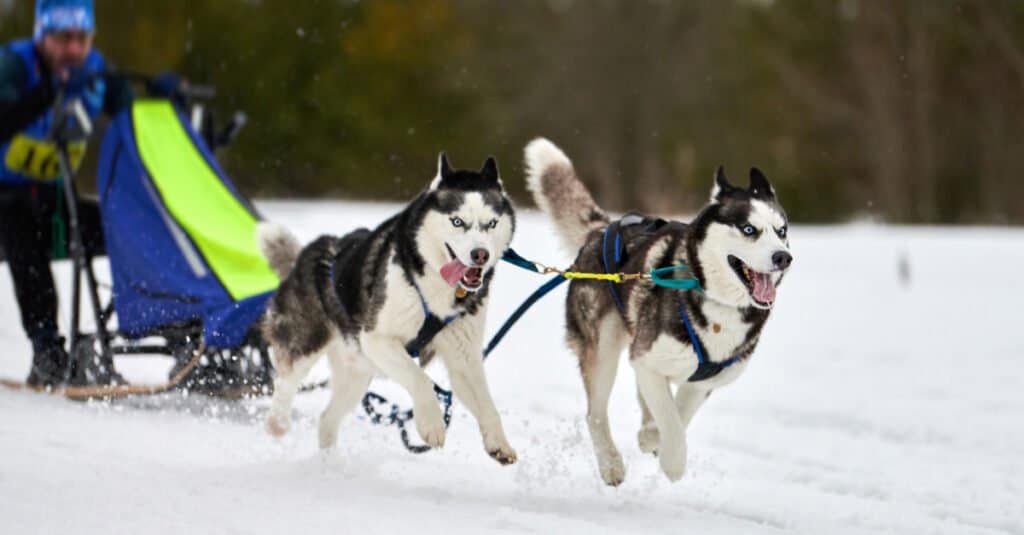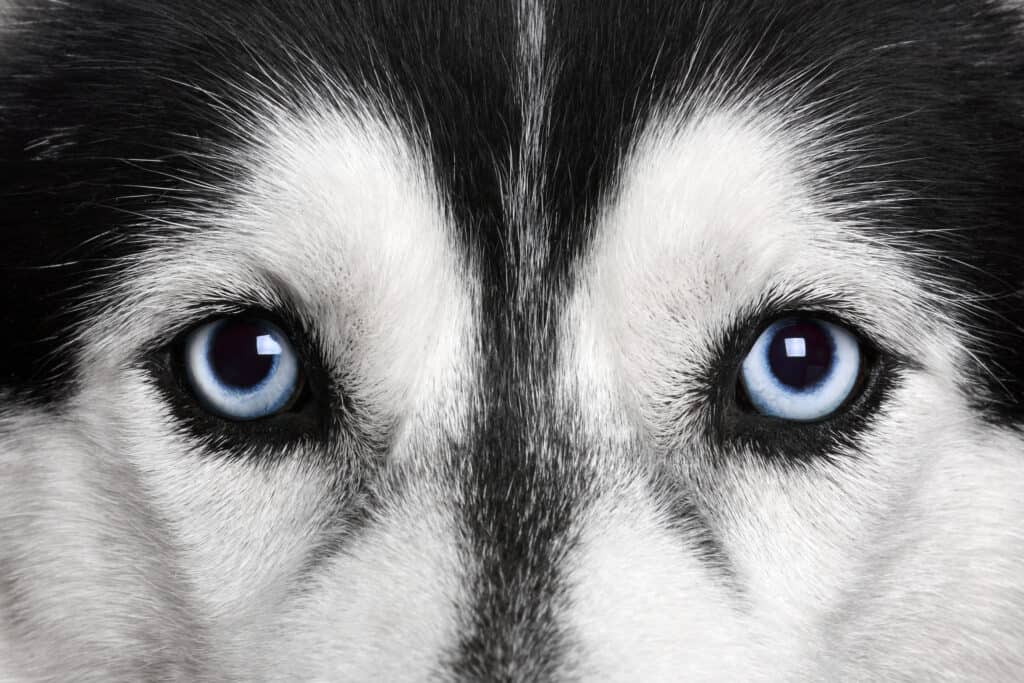Siberian huskies and the term, “troublesome dogs,” are usually unrelatable terms in most people’s minds. Part of that is the fact that pit bulls dominate the headlines whenever dog attacks on humans occur. To be fair, pit bulls and rottweilers are the top two dogs on the list of most dangerous dog breeds, which often draws attention away from other potentially problematic dogs.
Siberian huskies tend to hover around the 5th or 6th mark on most of these lists. “Dangerous” is often a very loose term as well. For example, Siberian huskies are responsible for exactly one death per year. That’s not exactly top of the news material and, when it does happen, it’s often well under the radar, outside of local news reports.
With that being said, are Siberian huskies truly troublesome dogs? There is a lot of ground to cover here, including hereditary behaviors, social behaviors, and the most common complaints about Siberian huskies (which may or may not have anything to do with husky violence).
Siberian Husky Hereditary Behavior

The
Siberian
Husky is well-known for pulling sleds through deep snow.
©travelarium.ph/Shutterstock.com
All dogs descend from gray wolves. How far they branch down from their cousins in the wild depends on the extent of breeding and domestication in their history. Huskies are no different, though the wolves huskies descend from are unique in their own right.
The husky is related to an extinct wolf, known as the Taimyr wolf, and four, distinct breeds of wolf that primarily existed in high-altitude areas. This makes sense considering the heavy pelt the husky carries around, its powerful legs, and its medium build. Huskies are also highly energetic and considerably more athletic than all that beautiful white, gray, and black fur suggests.
Today’s Siberian huskies descend from Lake Baikal and East Siberian dogs (as well as the tiamyr wolf), both of which are Arctic breeds. Taimyr wolves were no more or less aggressive than gray wolves. However, wolves are wild and unpredictable. As wild animals, they have a loose understanding of survival versus domestication.
A tame wolf that likes humans well enough, is far more likely to attack and eat a human, thanks to centuries of survival instinct, rather than the malevolent deviousness often associated with them. The closer a dog is related to the gray wolf, or a wolf of any kind, the more prevalent that survival urge may be.
Fortunately, Siberian huskies have centuries of domestication under their belts (or pelts, if you prefer). Their genetic disposition toward sudden survival violence, born of the instinct of the tiamyr wolf, was bred out of the breed centuries ago.
Siberian Huskies Social Behavior
If Siberian huskies don’t have an instinctive predisposition to become troublesome dogs, the next thing we have to lean on is social behavior. Pit bulls are a primary example of this. Pit bulls owe their lineage to the first half of the 19th century, as a descendant of English bulldogs, bred entirely for “bull baiting.”
Bull-baiting is a descriptive term for dog fighting, and there is little doubt that the succeeding generations following the pit bull’s inception changed much. Pit bulls are highly prized fighting dogs in many parts of the world, including countries where dog fighting is illegal.
So, why are we talking about pit bulls in a husky article? The reason is simple. The pit bull is a glaring example of dog behavior that directly results from social behaviors and norms in humans. The question here is whether or not the Siberian husky follows the same path or a similar one.
Fortunately, people across the world don’t typically use Siberian huskies in dog fights (illegal or otherwise). However, huskies are predominately working animals, with a long history traversing mountainous regions, surviving in harsh conditions, pulling sleds, and surviving in some of the harshest conditions on the planet.
They were never bred for aggression or fighting but for power and endurance. Today’s huskies benefit from the athletic capabilities of their ancestors, but not necessarily in an aggressive way. From a social perspective, Siberian huskies are not troublesome dogs in most aspects, because people don’t socialize them negatively.
Common Complaints About Siberian Huskies

Although Huskies weigh only 60 pounds, they’re strong for their size.
©244162930/Shutterstock.com
So, now that we know Siberian huskies are not troublesome dogs, at least in terms of vicious attack animals, we move on to the common complaints about them. Though there are five types of husky (Siberian, Alaskan, Greenland, Sakhalin, and Mackenzie River), the behavioral patterns are roughly the same.
1. Huskies Are Large
This is a common complaint about huskies, and it mostly comes from people who have never owned a husky and purchased their husky as a puppy. It’s also a bit of an exaggeration. For instance, if you shave a husky, removing all of its hair, you’ll discover a drastically smaller dog. Huskies are medium-sized dogs, and most of their size appearance comes from their fur.
However, they are big enough to knock small children down when walking by. German Shepherds, Doberman Pinschers, Rottweilers, etc., are all medium-sized dogs, even though they appear larger than life in our imaginations.
2. Huskies Are Highly Energetic
Many people mistake aggressive and energetic enthusiasm for viciousness. The husky is responsible for much of the former and very little of the latter. They are highly energetic dogs, mostly due to their breeding as working animals. They have a genetic predisposition towards channeling that energy into climbing mountains, hunting food, and pulling sleds.
When trapped in the much smaller confines of a house, it’s enough to turn a dog into a constant whirlwind of energetic enthusiasm. That’s not to say that huskies are incapable of being lazy lapdogs because they certainly are.
Most people aren’t prepared for all of that energy and purchase husky puppies while living in a small home or apartment. Huskies also play hard. The only way a dog has to grab things while playing is with its mouth. This turns into a nightmare scenario when little children play rough with a husky.
3. Huskies Are Violent Dogs
Whether or not Siberian huskies are troublesome dogs is irrelevant in the face of this accusation. After all, this is the worst of the worst. “Troublesome” doesn’t begin to describe the damage a husky is capable of, after all. The question here is two-fold. Who are the ones accusing huskies of violent behavior? Are huskies deserving of the label?
To address the first question, most people who claim huskies are violent dogs have either had a negative experience with one or have never owned one at all. An oft-referenced study that claimed huskies were the most dangerous dogs is one from over a decade ago, conducted by Hill & Associates.
Since then, many studies don’t even include huskies in their top ten. For instance, a study from the University of Helsinki (a far more recent study as well), doesn’t list huskies in its entire top 23. The rough collie, miniature poodle, miniature schnauzer, German shepherd, and Spanish water dog make up the top 5.
4. Huskies Are Not Loners
One of the primary complaints in the Siberian huskies are troublesome dogs category, is the need huskies have for consistent companionship. Huskies are not the kind of dog that prefers long, lonely days at home. At the very least, they require a companion dog to keep them occupied while their owners are working all day.
Huskies may become more aggressive or misbehave more if they are neglected when it comes to spending time with them. They are social dogs and highly energetic. Without attention and affection, huskies will easily devolve into a dog that’s difficult to handle at home.
5. Health Issues With Huskies
Health issues will also contribute to misbehavior in huskies. All purebred dogs tend to have more health problems than their mixed-breed counterparts. Huskies are not an exception to the rule. Since huskies are sociable and require companionship, they tend to suffer from separation anxiety and depression when they lack social interaction.
Huskies are also prone to eye problems, hip dysplasia, hypertension, epilepsy, inflammatory bowel disease, cancer, and hyperthyroidism. Not only are these problematic for the husky, but they are also problematic in terms of expense. Treating these issues long-term is very expensive.
Final Thoughts
Siberian Huskies are big-looking dogs, so there are natural assumptions about them. They are also wolf-like in appearance, which certainly doesn’t do them any favors with public opinion. However, many of the common complaints about Siberian huskies being troublesome dogs come from unique situations, where the owner is often as much at fault as the dog, if not more so.
Siberian Huskies have their fair share of issues, being a purebred, high-maintenance dog. What they don’t have is a behavior geared towards violence. Outside of the 2012 study, huskies rarely find themselves on any kind of list that has the backing of a scientific study. Regardless of this, they often find themselves on the aggressive dogs list. Much of this is more due to perception, rather than what today’s studies indicate.
The photo featured at the top of this post is © iStock.com/Elayne Massaini
Ready to discover the top 10 cutest dog breeds in the entire world?
How about the fastest dogs, the largest dogs and those that are -- quite frankly -- just the kindest dogs on the planet? Each day, AZ Animals sends out lists just like this to our thousands of email subscribers. And the best part? It's FREE. Join today by entering your email below.
Thank you for reading! Have some feedback for us? Contact the AZ Animals editorial team.







